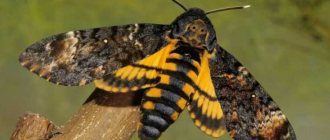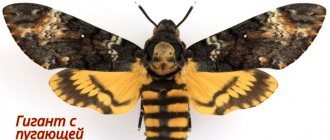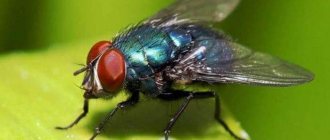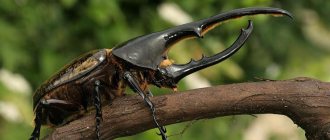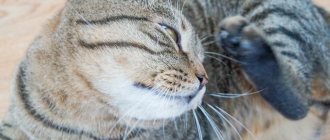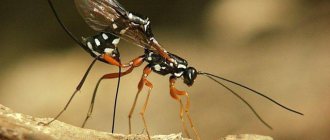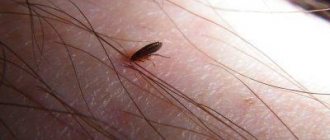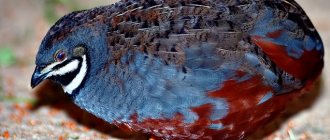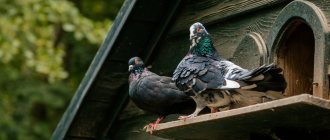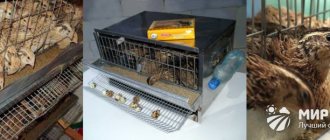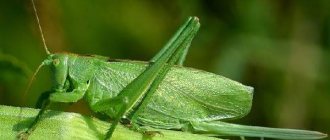Hawkmoths are insects from the Lepidoptera family. These are large and medium-sized butterflies with an original color. They are heat-loving insects, but during migration they fly north of their usual habitat regions. There are more than 1 thousand species in the world that belong to this family. Tobacco hawk moth is widespread on the American continent. Insect caterpillars feed on leaves of tobacco and related crops (tomatoes, potatoes). Butterflies reproduce quickly in captivity and are used by scientists as a model organism to study wildlife.
Description
Butterflies with a wingspan of 9.5-12 cm. The front wings have a blurred pattern of brown, black and white flowers; on the hind wings there are alternating light and brown stripes flowing into each other, the hind wings have 2 black zigzag median lines located very close to each other. The underside of the abdomen is brown, there are yellow spots on the sides of each segment (looks like 6 pairs of yellow stripes), and the front is dark. Males have much wider antennae than females.
The eggs are spherical in shape, about 1 millimeter in diameter, transparent green. The caterpillars grow to approximately 70 millimeters in length and have a red horn at the end of their abdomen.
They are green in color and have seven light stripes on their sides, like those of death's head caterpillars (Acherontia atropos). There are six subspecies.
Synonyms
- Sphinx sexta
Linnaeus, 1763 - Protoparce sexta
- Phlegethontius sexta
- Sphinx carolina
Linnaeus, 1764 - Manduca carolina
- Phlegethontius carolina
- Protoparce carolina
- Macrosila carolina
- Protoparce jamaicensis
Butler, 1876 - Sphinx lycopersici
Boisduval, - Sphinx nicotianae
Boisduval, - Sphinx paphus
Cramer, 1779 - Protoparce griseata
Butler, 1875 - Protoparce leucoptera
Rothschild and Jordan, 1903 - Protoparce sexta luciae
Gehlen, 1928 - Protoparce sexta peruviana
Bryk, 1953 - Sphinx caestri
Blanchard, 1854 - Sphinx eurylochus
Philippi, 1860 - Sphinx tabaci
Boisduval, - Protoparce sexta saliensis
Kernbach, 1964
Nutrition
The caterpillars feed on plants of the nightshade family (Solanaceae), primarily tobacco (Nicotiana spec.). They tolerate the nicotine it contains well and can accumulate it in the body, which makes them inedible for predators (“pharmacophagy”). They also feed on datura (Datura wrightii), tomato (Solanum lycopersicum, Solanaceae), capsicum (Capsicum annuum) and small-flowered proboscidea (Proboscidea parviflora, Martinia family). Plants serve not only as food and habitat for caterpillars - adult hawk moths also feed on them, but with nectar. Adults can also use other plants as a food source, finding them using a well-developed sense of smell. In particular, we can mention agave (Agave palmerii), especially popular with hawk moths living in Arizona. This agave, which is actually adapted for pollination by bats, is used by hawk moths as a food source when D. wrightii is still scarce.
Synonyms
- Sphinx sexta
Linnaeus, 1763 - Protoparce sexta
- Phlegethontius sexta
- Sphinx carolina
Linnaeus, 1764 - Manduca carolina
- Phlegethontius carolina
- Protoparce carolina
- Macrosila carolina
- Protoparce jamaicensis
Butler, 1876 - Sphinx lycopersici
Boisduval, - Sphinx nicotianae
Boisduval, - Sphinx paphus
Cramer, 1779 - Protoparce griseata
Butler, 1875 - Protoparce leucoptera
Rothschild and Jordan, 1903 - Protoparce sexta luciae
Gehlen, 1928 - Protoparce sexta peruviana
Bryk, 1953 - Sphinx caestri
Blanchard, 1854 - Sphinx eurylochus
Philippi, 1860 - Sphinx tabaci
Boisduval, - Protoparce sexta saliensis
Kernbach, 1964
Mating and development
Females mate only once, males can mate several times. Mating occurs at night on the ground and can last several hours. The female then lays eggs singly on the leaves of food plants, usually on the underside, but sometimes on the top. The caterpillars hatch two to four days after the eggs are laid. After five molts they pupate in the ground. The formation of the pupa is preceded by a stage called prepupa, during which the caterpillar significantly decreases in size and prepares for metamorphosis. Caterpillars are often mistaken for dead or withered during this phase.
Prepupa
Ideally, the pupal phase lasts about 18 days, taking into account the presence of a 17-hour daylight hours; When daylight hours are less than 12 hours, pupae can go into diapause for several months.
Damage to agriculture
Tobacco hawk moth larvae cause significant damage to tobacco plantations and tomato crops. They settle on the upper part of leaves and eat them and green fruits. At a young age, pests easily blend in with green plants and are difficult to notice. They are usually found at the end of the larval period, when large caterpillars eat large quantities of leaves. Insect control measures are aimed at all generations. Natural enemies help control the number of pests.
Natural enemies
There are a number of parasitoid braconid parasitoid parasitoids, such as those belonging to the genus Cotesia, the larvae of which develop in the caterpillars of hawk moths. At the same time, many ichneumon ichneumon larvae can simultaneously parasitize the caterpillar. After the larvae pupate, the dead caterpillar is covered with their white cocoons.
Empty cocoons and an adult Cotesia_congregata ichneumon on a caterpillar
Synonyms
- Sphinx sexta
Linnaeus, 1763 - Protoparce sexta
- Phlegethontius sexta
- Sphinx carolina
Linnaeus, 1764 - Manduca carolina
- Phlegethontius carolina
- Protoparce carolina
- Macrosila carolina
- Protoparce jamaicensis
Butler, 1876 - Sphinx lycopersici
Boisduval, - Sphinx nicotianae
Boisduval, - Sphinx paphus
Cramer, 1779 - Protoparce griseata
Butler, 1875 - Protoparce leucoptera
Rothschild and Jordan, 1903 - Protoparce sexta luciae
Gehlen, 1928 - Protoparce sexta peruviana
Bryk, 1953 - Sphinx caestri
Blanchard, 1854 - Sphinx eurylochus
Philippi, 1860 - Sphinx tabaci
Boisduval, - Protoparce sexta saliensis
Kernbach, 1964
Interesting Facts
Butterflies and caterpillars are used as model organisms, especially in neurobiology for studying the nervous system, because they have a short life cycle and are relatively easy to keep and breed on wheat germ feed, and their internal organs are easy to dissect due to their size.
The caterpillar's intestines "dangle" in the body. Studies have shown that when walking, the intestines are immediately moved forward by the hind legs, followed by the pseudopods and true legs. This movement of the intestines, independent of the membrane, is, as far as is known, unique in the animal kingdom.
At the Max Planck Institute for Chemical Ecology (Germany), researchers have discovered a surprising strategy of tobacco plants in combination with Manduca sexta: while wild tobacco usually defends itself against predators by stimulating nicotine production, it does not react this way when damaged by the tobacco hawk moth caterpillar. Apparently, these plants recognize the caterpillar by its saliva and do not try to drive it away, which ultimately benefits both the plant through pollination by the adult butterfly, and the butterfly itself and its offspring.
All articles
Captivity
It is not uncommon to find tobacco hawk moths in captivity. The purpose of their breeding may be to use the larvae as food for various reptiles, fish and small mammals. In order to keep and breed them, you need to study a number of rules and requirements for caring for these beautiful insects. Before you get a tobacco hawkmoth, you need to think about the container where it will live.
Almost any container with dimensions of at least 40x40x40 will do. This container serves as a collection of larvae. For the development of butterflies you will need a medium aquarium, a mesh cage and a vertical terrarium with good ventilation. Branches of deciduous trees should be placed inside the aquarium, since this is where caterpillars can live. It is best to lay the bottom with soil and stones. In winter, the aquarium should be covered with sphagnum moss and damp sawdust.
Also, for the development of tobacco hawk moth individuals, constant lighting is necessary. Use a spray bottle to maintain humidity.
It is worth considering that when the caterpillar begins to exceed 6 centimeters in size, it becomes ready for pupation. During this period, you can notice that she is restless, practically does not eat, and the color of the cover begins to fade. In order for this period to pass safely, the caterpillars are transplanted to the bottom of a separate container, which should contain at least 5 centimeters of peat. She will burrow into it and begin the process of transforming into the pupal stage.
Ways to get rid of milkweed in your summer cottage
Despite the fact that the only type of milkweed grows in the garden, we still haven’t figured out how to fight it - there is no reliable remedy.
Therefore, several methods are applicable for his expulsion, complementing (but not replacing) each other.
Control methods include the use of:
- agrotechnical practices;
- chemicals;
- folk ways.
Agrotechnical methods
They represent a set of sequential operations, the result of which should be the depletion of the weed's rhizome - all its strength lies in it.
Regular, methodical tearing off of the regrown stems of the pest negates the attempt of the roots to grow a complex of “solar batteries” for themselves (after all, without photosynthesis produced by the leaves, the plant will die).
Removing weeds from the site
Therefore, the task of the owner of an area infested with milkweed is to carefully monitor the condition of the bush every day - allowing its shoots to grow to a considerable height is the same as planting new ones with your own hands.
In the case when planting is just being planned, and milkweed is already growing in a given place, you should excavate not only in depth, but also in breadth in order to select the underground shoots as completely as possible.
Excavation of the earth
If the weed has penetrated under the fence, neighboring summer residents should be involved in joint activities (otherwise the personal headache will soon become a common one).
Use of chemicals
If you wait until harvest time, the milkweed will not only spread even wider, but will also have time to produce seeds (this is another way for the plant to reproduce).
Milkweed seeds
Of the ready-to-use herbicides in convenient aerosol packaging, you should pay attention to:
- "Tornado";
- "Lontrel-300D";
- "Lapis lazuli";
- "Titus."
If you detect sprouting of milkweed among garden plants, you can specifically “burn” the weed with Roundup.
Following folk wisdom
It has been noticed that without sunlight, any plant loses its strength. The method of covering problem areas with light-proof material allows you to lime the most tenacious and hardy plant in a given place.
Since underground shoots are only storage areas for nutrients, and they are formed in the leaves, it is quite logical to deprive their production of the basis - the energy supplied by the sun. The leaves left without light will first turn pale, then wither and the life in them will dry up, and the roots will die along with them.
Any materials are suitable for covering - from black non-woven fabric (Lutrasil) to cardboard and newspapers, stacked on top of each other, to the level of light impermeability, in several layers).
Bed covered with black cloth
But a method that is so popular among summer residents as spilling milkweed soil with a saline solution (made from table salt) is not recommended. Because you should think about the future, because if root crops do not grow in a given area, then it is quite possible to quickly plant berry bushes (currants, gooseberries).
Conclusion
Since milkweeds are not just plants - products carefully selected for existence by evolution itself, they have to be fought with all available methods.
The question is, in the pursuit of momentary success, not to harm the overall health of the entire area (we are talking about measures similar to those taken in the fight against moles). For land is given not for years, but for centuries - not only for the present, but also for all future generations.
Synonyms
- Sphinx sexta
Linnaeus, 1763 - Protoparce sexta
- Phlegethontius sexta
- Sphinx carolina
Linnaeus, 1764 - Manduca carolina
- Phlegethontius carolina
- Protoparce carolina
- Macrosila carolina
- Protoparce jamaicensis
Butler, 1876 - Sphinx lycopersici
Boisduval, - Sphinx nicotianae
Boisduval, - Sphinx paphus
Cramer, 1779 - Protoparce griseata
Butler, 1875 - Protoparce leucoptera
Rothschild and Jordan, 1903 - Protoparce sexta luciae
Gehlen, 1928 - Protoparce sexta peruviana
Bryk, 1953 - Sphinx caestri
Blanchard, 1854 - Sphinx eurylochus
Philippi, 1860 - Sphinx tabaci
Boisduval, - Protoparce sexta saliensis
Kernbach, 1964
Reproduction
The hummingbird-like butterfly prefers to lay its eggs on food plants. She does this on the fly, attaching them one at a time. They form caterpillars, the size of which directly depends on the type of hawk moth. They can be yellow-green or brownish-red in color with white dotted warts, black spiracles and longitudinal stripes of white, yellow or red located near the “legs”. Almost immediately after their appearance, they begin to eat the leaves of the plants closest to the place of oviposition, as a result of which the shoots become bare and soon die. Hawkmoth caterpillars can cause significant damage to most agricultural crops, among which grapes and potatoes suffer most from their invasions.
Before pupation, hawkmoth caterpillars turn red and burrow into the ground without a cocoon. Despite the fact that the cover of the proboscis of the pupa is soldered, it still protrudes glue-like. The color of the pupa is light and can vary depending on the type of hawkmoth from gray-brown to bluish-green.
Links
- [https://www.danaida.ru/sem14/mans.htm Carolina hawk moth (Manduca sexta)] on the website [https://www.danaida.ru/ Butterflies] (Russian)
- [https://www.colostate.edu/Depts/CoopExt/4DMG/Pests/tomato.htm Manduca sexta: description on the Colorado State University website] (English)
- [https://ohioline.osu.edu/hyg-fact/2000/2113.html Nuisance Parasitic Wasps at Ohio State University Extension] (English)
- [https://www.butterfliesandmoths.org/species/Manduca-sexta Manduca sexta on the Butterflies and Moths of North America website] (English)
- [https://entomology.ifas.ufl.edu/creatures/field/hornworm.htm Manduca sexta on the University of Florida website] (English)
- [https://jeremyswan.com/materials/photography/index.html Manduca sexta: anatomy illustration] (English)
Synonyms
- Sphinx sexta
Linnaeus, 1763 - Protoparce sexta
- Phlegethontius sexta
- Sphinx carolina
Linnaeus, 1764 - Manduca carolina
- Phlegethontius carolina
- Protoparce carolina
- Macrosila carolina
- Protoparce jamaicensis
Butler, 1876 - Sphinx lycopersici
Boisduval, - Sphinx nicotianae
Boisduval, - Sphinx paphus
Cramer, 1779 - Protoparce griseata
Butler, 1875 - Protoparce leucoptera
Rothschild and Jordan, 1903 - Protoparce sexta luciae
Gehlen, 1928 - Protoparce sexta peruviana
Bryk, 1953 - Sphinx caestri
Blanchard, 1854 - Sphinx eurylochus
Philippi, 1860 - Sphinx tabaci
Boisduval, - Protoparce sexta saliensis
Kernbach, 1964
Notes
- A. Semenov (1898). “Callipogon (Eoxenus) relictus sp.
n., Vertreter des neotropischen Genus der Cerambyciden in der russischen Fauna” . Horae Soc. Ent. Ross. 32: 562–580. - (English). BioLib.cz. Retrieved January 5, 2011.
- Striganova B. R., Zakharov A. A.
Five-language dictionary of animal names: Insects (Latin-Russian-English-German-French) / . - M.: RUSSO, 2000. - P. 149. - 1060 copies. — ISBN 5-88721-162-8. - Life of animals. Volume 3. Arthropods: trilobites, chelicerates, trachea-breathers. Onychophora / ed. M. S. Gilyarova, F. N. Pravdina, ch. ed. V. E. Sokolov. — 2nd ed., revised. - M.: Education, 1984. - P. 282. - 463 p. — 300,000 copies.
- Chubaryan A. O., Ishchenko V. V., Kordonsky S. G. et al.
Encyclopedia of living nature / scientific.
ed. Vilchek G. E.
and
Glazov M.
V. - Moscow: Olma-Press "Ex Libris", 2006. - T. III. - P. 87. - 160 p. — 15,000 copies. — ISBN 594847-588-3. - Nikitsky N.B.
. feeco.narod.ru. Retrieved January 5, 2011. - ↑ Nikitsky N.B.
.
"Red Book"
. sevin.ru. Retrieved January 6, 2011. - ↑ Cherepanov A.I.
Longhorned beetles of Northern Asia (Prioninae, Disteniinae, Lepturinae, Aseminae). - Novosibirsk: “Science”, 1979. - T. I. - P. 48-51. — 700 s. — 1100 copies. - . ZIN.ru. Retrieved January 5, 2011.
- Oleg Berlov.
. ZIN.ru. Retrieved January 5, 2011. - ↑ Plavilshchikov N.N.
1 // Fauna of the USSR. Coleopterous insects. Woodcutting beetles / ch. ed. Zernov S.A. - Moscow-Leningrad: Publishing House of the USSR Academy of Sciences, 1936. - T. XXI. — P. 66-68. — 611 p. — 1700 copies. - Semenov, A.
Callipogon relictus, SP. N. Horae Soc. Ent. Rossicae (English). - 1898. - No. 32. - P. 562. - ↑ Red Book of the Amur Region: Rare and endangered species of animals, plants and fungi
. author-compiler Aboimov Yu.N. and others; — Blagoveshchensk: BSPU Publishing House, 2009 (PKI “Zeya”). — 444 -ISBN 978-5-8331-0188-9 - Byun, B. K. et al. 2006. Research Report on a Natural Monument, Callipogon relictus Semenov in the Gwangneung Forest, Korea. Korea National Arboretum. pp 46
- ↑
- ↑
- Key to insects of the Russian Far East. T. III. Coleoptera, or beetles. Part 3 / under general. ed. P. A. Lera. - Vladivostok: Dalnauka, 1996. - P. 69. - 556 p.
- ↑ Identifier of forest pests / Ilyinsky A. I. - Moscow: Selkhozizdat, 1962. - P. 298. - 392 p.
Where does the hawk moth live?
First of all, let us highlight the fact that they are very heat-loving. For this reason, they are especially abundant in tropical countries. In the middle zone, moths are less common. About 50 species can be found in Russia. They all love vegetation and live in forests. But there are exceptions: the turanga hawk moth loves the deserts of Central Asia.
Butterflies are awake at night. During the day, they all hide in the thick bark of trees. But the lilac hawk moth can feed around the clock. Before flying, butterflies have to flap their wings for a long time to warm their bodies. This is due to the fact that moths are cold-blooded.
In warm regions, butterflies are found all year round. When it is cold in the middle zone, they hide in a pupa, which is preserved in the soil or in moss.
It is worth noting that sometimes the migration of butterflies is caused not by a decrease in temperature, but by overpopulation of the area.
Some species of this butterfly live in the desert
Features of life
Probably every person has heard at least once in his life that a large insect similar to a hummingbird was seen in his city. According to eyewitnesses, it hovers over a flower and drinks nectar from it. However, this is not a small bird at all, but an unusual butterfly - a hawk moth, which is often called a proboscis or tongue.
The number of hawk moths undergoes strong fluctuations every year. For example, under favorable climatic conditions, their population increases significantly, and if there is a large amount of precipitation during the warm season, they are quite rare.
Moreover, even if the climate is extremely favorable for their reproduction, it is almost impossible to track general trends in population changes. This is directly related to the fact that an insect similar to a hummingbird makes frequent migrations over considerable distances, flying from southern to northern regions, where most individuals simply die from the cold. Moreover, their flight speed can reach 50 km/h.
What does an insect look like?
As noted earlier, representatives of this family are large-sized individuals. The insect's sufficient heaviness is ensured by its impressive body, which takes the shape of a cone. The butterfly's wings are partially retracted, their span varies from 3.5 centimeters to 17.5 centimeters. Interesting characteristics can be given to the antennae of an insect: quite long, pointed at the ends, and shaped like hooks. In the upper part of the hawk moth's body there are eyes, which are crowned with eyebrows formed from small scales. At a lower level in relation to the eyes is the proboscis, which, when deployed, can reach a length that easily exceeds the size of the moth's body. The spines on the insect’s legs also play the role of a “highlight”, since most butterflies make do with only an abundance of hair.
The lower part of the hawk moth's body is completely covered with scales. What is interesting is its elongation through this protective layer: towards the end of the abdomen the scales continue, thereby creating a tail. The large wings of the hawkmoth located in the front part are pointed at the top. The outer edge varies: in some individuals it is predominantly smooth, while others boast a carved design. The hidden hind wings are smaller than the front wings. They are characterized by bevels and notches at the ends.
Hawkmoth larvae often live in the crowns of trees such as birch or alder, linden or chestnut, pear or apple. There they appear at the end of the first summer month.
On the Internet you can find a huge number of photographs depicting hawk moth butterflies. But many users note that digital media cannot convey the amazing beauty and unusualness that nature has endowed this insect with.
